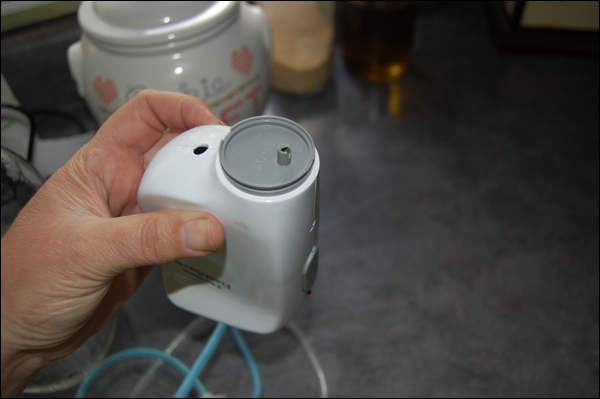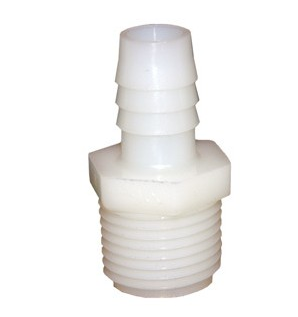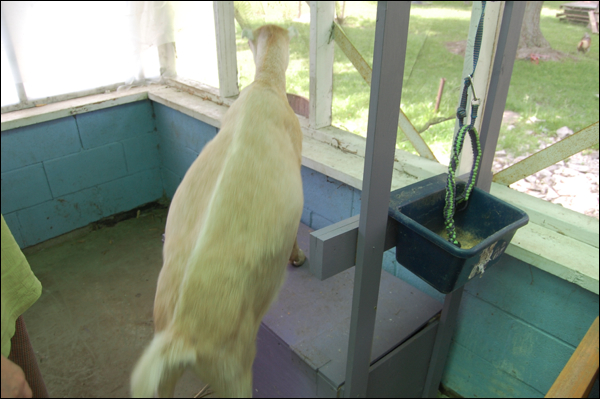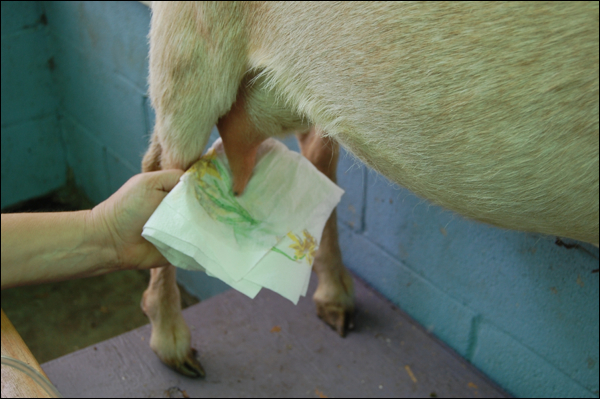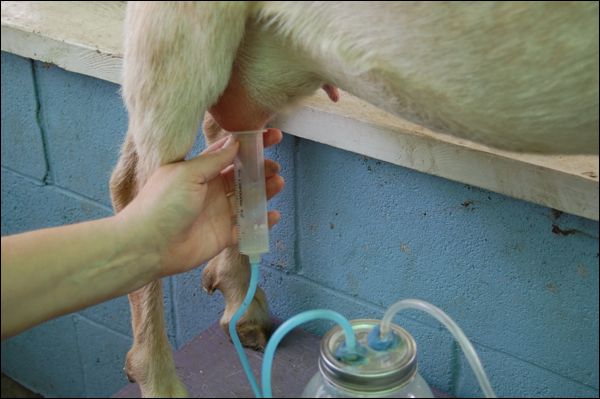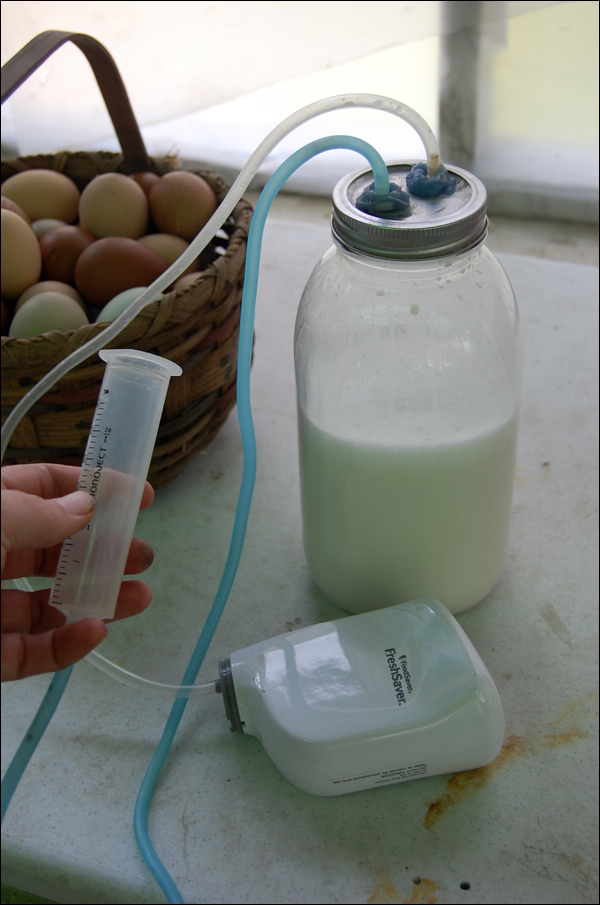We get asked all the time about our little portable home milking machine. We found the idea online, but the folks there were charging a little too much for my cheap ways. And besides, it looked pretty darn simple, actually.
All you need are the following:
A Foodsaver Hand Pump – Available at big box places like Walmart for about $20
Some plastic aquarium tubing. I used 1/4 inch diameter tubing because it was easy and cheap. $3.00 for 25 feet
A big plastic syringe. I got the largest one they had at the Tractor Supply. It has to fit over your milk doe’s teat. Ours was 59 cents.
Two plastic 1/4 hose barb fittings with screw on nuts. $2.00 (These are the hardest part to find, and most hardware stores should have them. We had to hunt around a bit, but ended up in fittings for gas lines and ice makers!) You can also order them off eBay for very cheap…
And a nice big mason jar for your milk. With a metal lid. (In hindsight, I wish I had made mine in a wide mouth jar so that I could milk quarts and store them. I probably will do that soon.) But a small mouth one works just fine, too!
Okay, first up. The pump comes with a little blue plastic inflator thingy over the top where the little suction thingy is. Remove that. It just pops off for easy cleaning anyway. You don’t need it. And then we found that if you took a sharp little knife and cut away the top of the little small nozzle, it works 100% better. Because the hole for suction is on the side and when you slip the hose over it, it blocks the flow. Even sharp scissors will take the top off. You want easy and fast pump action.
Then cut a piece of hose the length you want. We made ours about 18 inches or so. Enough so that the jar could set on the floor and not get kicked. Attach it to a syringe sleeve… remove the inner plunger part. Simple.
The hardest part is the lid. And it’s not that hard. Drill two holes in the metal lid, a wee bit smaller than the connector. You might mess one lid up, so have another just in case. You want to be able to push the two hose barbs into the top of the metal lid snugly. You have to keep a vacuum in your system to work well. Then apply the little nut and a washer if you can get one, to the barb connectors. Tighten snuggly. We added a little blue silicone sealant around the connections. (Sorry it looks a little icky… We wash them out after every milking but this area can get a little dirty. Thankfully the barbs and such are so cheap, we just pitch them and get new often to keep everything sanitary. This lid is due to be changed out. ) 
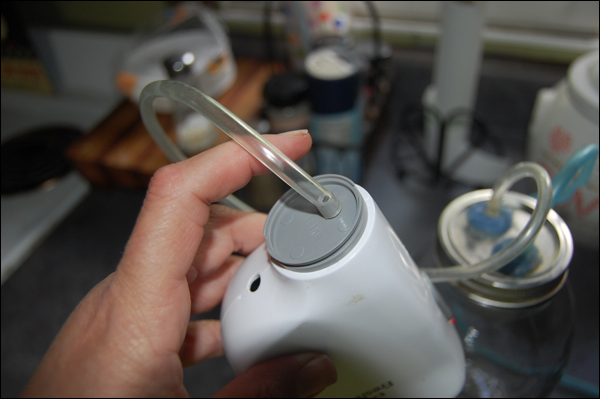
Slip your hose over the little sucking nozzle on the food saver, attached to a piece of hose into the jar and you are done! It took us less than a half hour to put it all together. Easy peasy.
The nice part about getting a hank of hose (25 feet or so) is that you can pitch the hose as it gets a little cloudy. We rinse everything in super hot water and let it dry, but no matter what, there will get a sort of cloudy look to the hose after awhile. Just ditch it and put new hose on when that happens.
As you can see, it’s hose to pump, then to jar and then another hose to teat cup and to the jar. Seal it up and you are ready to go. 
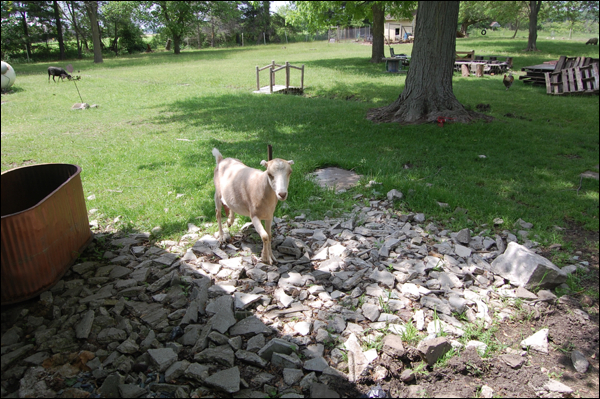
First, call your lovely milk doe to milking! Buttercup is ready for her time on the stand.
Get goat on the stand and apply snacks.
Happy goat.
Just like normal milking, you should wash the teats and udder. I do a little gentle bump on her udder like a kid would to help let down her milk. And then strip out a bit of milk from each teat to make sure everything is flowing nicely. 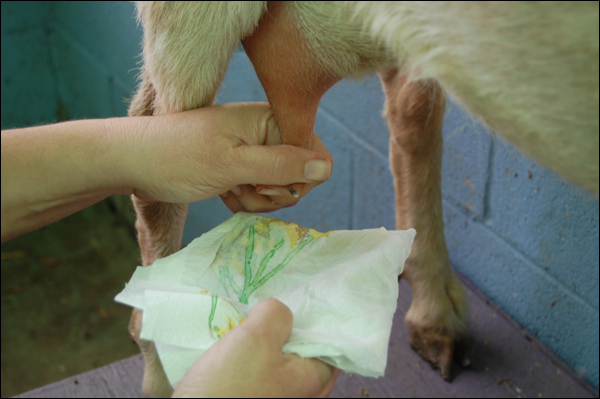
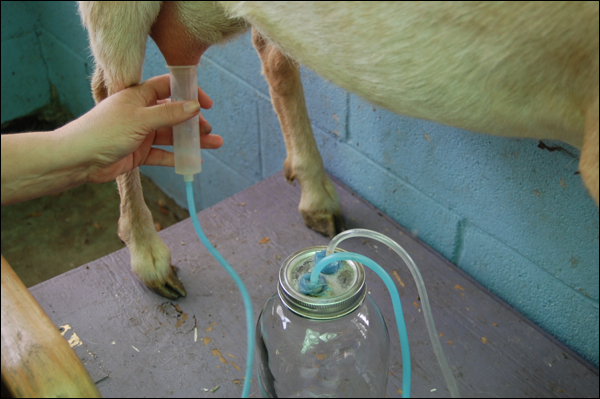
Attach the cup to the teat and make sure it’s snug up to the udder. It should fit comfortably, if you have to force the cup on, then you need a larger syringe. A few moments on the pump button, turning on the pump, until you see milk flowing nicely, then stop. I like to hold the pump in one hand and watch the cup closely with the other. You want enough suction so that the milk flows but not so much that the teat gets sucked way down into the cup. Watch your doe for any signs of discomfort.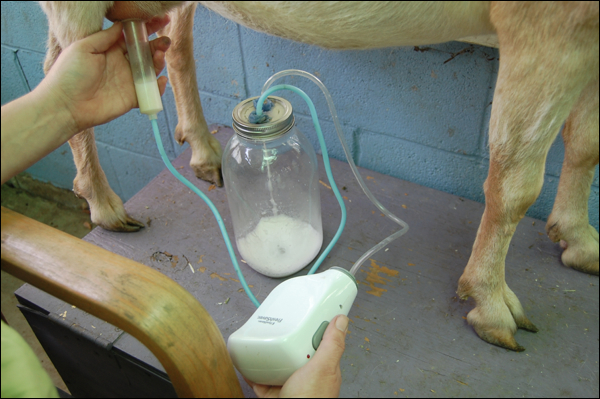
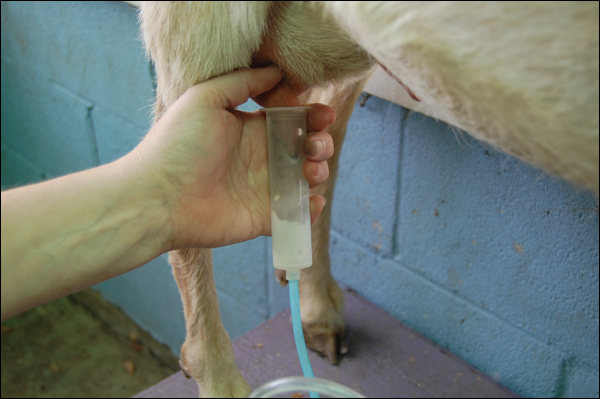
I milk for a few moments on one teat, then using my thumb, I break the suction by pressing into her udder a bit and it quickly looses the seal. Then switch to the other teat. I find that this is more comfortable for the doe then milking out one side completely. You will get to a good rhythm with your milking. It goes pretty quickly. I’ve never counted but I would say I do about three times on each side generally. I try not to let the suction stay on for more than a three or four minutes, I would say. A commercial milk machine pulses to simulate a nursing animal and I think also to give the teat a break from constant suction. You can easily mimic that with switching back and forth. 
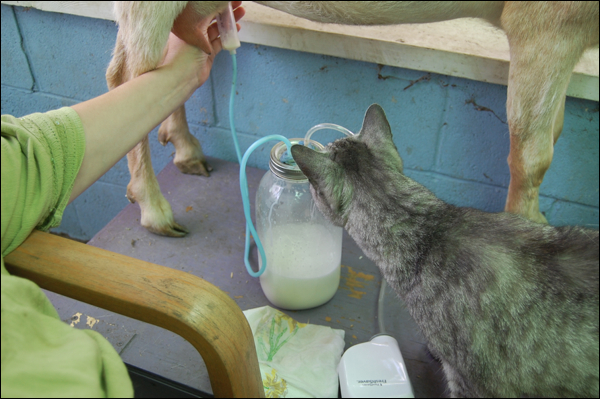
Kitty Luna approves of this procedure and is waiting her turn for a little sip of nice warm goat milk!
And I’ve noticed that with my doe, she doesn’t seem to mind at all. In fact, I’d wager she likes this better because it’s quicker, completely milks her out and there isn’t so much tugging and such going on. You will know when she is done because the udder will soften considerably and the teat stops flowing nicely… sometimes it will still be a dribble, but if you see the udder crinkling up and sucking into the cup too much, it’s time to stop.
All in all, our homemade milker cost about $30 to build and most of that was the little Food Saver pump. We’ve had one for all our milking experiences, one doe, two seasons now. And it’s rechargeable so you just plug it in every couple days and you are ready to go. Ours hold a charge for about 4 milkings so you can even forget now and then to plug it in and you can still milk.
When we are done, we just run super hot water through the cup and hoses and let air dry.
It’s easy on your hands, quick and allows you to enjoy milking without a lot of fuss. I still enjoy hand milking now and then, but to be honest, this is so much neater, easier and sanitary I think. No more hairs or feet in your bucket. I like that I can then just store the jar in the frig right away or even pop in the freezer for a fast chill and then into the frig after 15 or 20 minutes. I find that it really does away with ANY goaty taste. We use our milk to feed our bottle lamb as well as make cheese and bake and drink with. It’s a pretty cool thing. We only milk once a day and our doe gives just under a half gallon of milk. It’s perfect for our family of three!
Email if you have any questions to ask! Sherri@chekal.com


